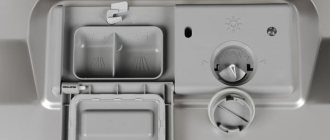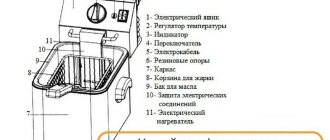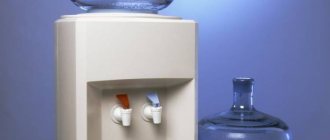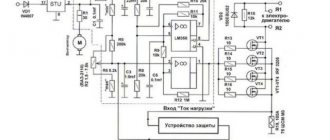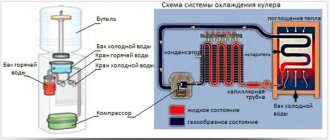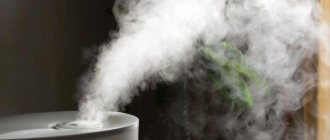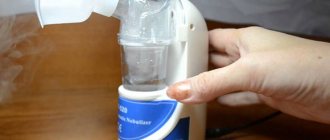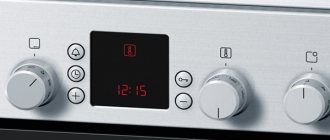Water cooler device
The cooler is a fairly simple design. Has the following components:
- water container - container - depending on the model;
- dispenser;
- connection pipe - ensures the flow of water into the boiler;
- check valve - regulates the balance of the pressure system inside the device.
Types of cranes
Crane-push
This is the simplest and most common design, which is found on approximately 70 percent of all coolers produced.
The benefits of having a tap are as follows:
- Low price. It is achieved thanks to a simple device that does not include any expensive elements in its structure.
- Simple instructions for use. All you have to do is bring a cup or glass and press its edge onto the trigger. So, you only need one hand to use devices of this design.
- Interchangeability. If the faucet fails, it will not be difficult for you to buy a suitable replacement model.
The main disadvantage of push-type structures is their low practicality, due to the following circumstances:
- High loads on the functional part, which is responsible for pressing the silicone seal into the device, which leads to its wear and deformation. This especially applies to taps operating with warm water, since high temperatures significantly reduce the service life of their internal parts.
- In addition, as a result of sudden and strong pressure, a crack may appear in the silicone seal itself.
- In addition, it is necessary to emphasize that the models under consideration are located outside the dispenser, and this significantly increases the susceptibility to external mechanical actions associated with careless operation. This especially applies to children with their tireless energy and public places where people may have a disdainful attitude towards things that are not theirs.
Lever
The main difference between this option and the previous one is that it requires a second hand to operate it. In other words, you bring the glass to one, and with the other you pull the lever so that the water flows. On the one hand, such a system protects against burns, but on the other hand, it is less ergonomic. The rest of their characteristics are similar.
Here we can already see clearer differences, which primarily relate to the fact that such products are located in the cooler itself.
Thanks to this feature, it is possible to immediately identify the following characteristic features:
- Reliability of the design. Since all the most critical elements are protected from external actions by the wall of the dispenser itself.
- The complexity of repair work, which includes disassembling the entire cooler.
| type of drive | Characteristic highlights |
| Mechanical |
|
| Electromagnetic |
|
Crane-push
This is the simplest and most common design, which is found on approximately 70 percent of all coolers produced.
The advantages of such a crane are as follows:
- Low price. It is achieved thanks to a simple device that does not include any expensive elements in its structure.
- Simple instructions for use. All you have to do is bring a cup or glass and press the edge of it onto the trigger. Thus, you only need one hand to use devices of this design.
- Interchangeability. If the faucet fails, then it will not be difficult for you to purchase a suitable replacement model.
We invite you to familiarize yourself with DIY car air freshener
The main disadvantage of push-type structures is their low practicality due to the following reasons:
- High loads on the functional part, which is responsible for pressing the silicone seal inside the device, which leads to its wear and deformation. This is especially true for taps operating with hot water, since high temperatures significantly reduce the service life of their internal parts.
- Also, as a result of sudden and strong pressure, a crack may appear in the silicone seal itself.
- It is also worth noting that the models in question are located outside the dispenser, and this significantly increases susceptibility to external mechanical influences associated with careless operation. This is especially true for children with their tireless energy and public places where people may have a disdainful attitude towards things that are not theirs.
Lever
The main difference between this option and the previous one is that it requires a second hand to operate it. That is, with one you bring the glass, and with the other you pull the lever so that water flows. On the one hand, such a system protects against burns, but on the other hand, it is less convenient. The rest of their characteristics are similar.
Here more expressive differences are already observed, which primarily relate to the fact that such products are located inside the cooler itself.
Thanks to this feature, the following characteristic features can be immediately identified:
- Reliability of the design. After all, all the most important elements are protected from external influences by the wall of the dispenser itself.
- The difficulty of performing repair work, which includes disassembling the entire cooler.
| type of drive | Characteristics |
| Mechanical |
|
| Electromagnetic |
|
Lever
How to clean a water cooler yourself: sanitizing at home
The device requires regular maintenance at all stages of its operation. You can carry out cleaning and disinfection yourself, without the help of professionals. Let's look at how to do this in detail.
Disinfection and cleaning products
The most popular remedy that removes stains is citric acid. It effectively softens plaque and removes it from the walls of the bottle and parts of the unit. Additionally, citric acid will disinfect surfaces and remove foreign odors.
The advantage of this treatment is the complete safety of the product both for human health and for the device itself.
Prepare the mixture as follows. Dissolve 100 of the dry product in five liters of water. Pour the composition into the cooler.
Iodine will cope well with contamination. Dilute 20 drops of iodine in the same amount of water. Pour the composition into the tanks and wait 5-7 minutes. The disadvantage of this treatment is stains. They can appear when drops of iodine accidentally fall on the cooler body. When the product comes into contact with metal parts of the device, corrosion occurs.
Ammonia is no less effective. Its weak concentration will cope perfectly with dirt and unpleasant odors. When working, use gloves to prevent burns. After treatment, rinse the cooler especially thoroughly - at least 4-5 times. Important! Do not turn on the heating function of the device while there is an ammonia solution in the tank - this will damage the device.
If plastic parts are heavily soiled, treat them with dishwashing detergent. Apply a few drops to a sponge, whip up foam and wipe the dirty areas. Attention! Work only with the soft side of the sponge, otherwise you will scratch the plastic.
Advice! When removing greasy stains, mix the detergent with table vinegar and water in equal proportions. Treat particularly stubborn stains with a mixture of water and baking soda. Apply the mixture carefully so as not to scratch the surface.
More effective are special formulations - polymer antiseptics. For example - guanoposept. It does not contain chlorine, it does not pose a danger to the body. For instructions for use, refer to the manufacturer's instructions.
Necessary equipment
For cleaning you will need:
- soft sponge;
- brush;
- wet and dry cloth;
- container for collecting water;
- gloves;
- waterproof cloth;
- disinfector - industrial or homemade;
- non-abrasive detergent.
The main problems encountered in the operation of the cooler
We can highlight the main problems that cooler users face.
The device does not heat water
It happens that the reason for such a malfunction is that the device is not connected to the power supply or the heating button is not turned on. If, after turning on the button, the heating indicator still does not light up, you should check the outlet itself. To do this, you need to connect any other device to it, or try connecting the cooler to a different outlet. Perhaps the reason is not in the outlet, but in the power plug of the device itself.
Another reason may be that the cooler simply does not have time to heat a sufficient amount of water, and it has recently been used in large quantities. In the instructions you can see how much water a particular device can heat and over what period of time.
If the heating button is turned on and the socket is working, but the water also does not heat up, you will need to disassemble the equipment.
This must be done as follows:
- Remove the panel located on the rear side;
- Check the fuse for functionality;
- Replace the fuse if faulty.
If this procedure does not bring results, you will have to contact a service center, since the breakdown is more serious and you cannot fix it yourself.
No water comes from the tap
This is not a malfunction, but rather a small problem that may arise due to the label remaining on the neck when installing the bottle. Another reason is the appearance of an air lock in the bottle, which interferes with operation.
To eliminate it, you need to rock the bottle with your hands in different directions until air bubbles begin to form in it.
Water regularly leaks and drips from the faucet
The reason may be a crack in the bottle itself. In this case, it is necessary to replace it, and the problem will be solved. If water continues to regularly drip from the faucet, you should contact a service center to have the problem repaired.
Cooler doesn't cool
First of all, you should check that the cooling button is turned on and that the socket is working properly. The reason for this may also be the technical capabilities of the device. Most devices require at least an hour to cool a liter of water.
Other malfunctions are quite rare and if they occur, you should contact a service center.
ATTENTION! You should not disassemble the cooler yourself while it is under warranty.
Professional washing: what is included in the service, duration and cost
Professional treatment is carried out in a special workshop - this gives a better result than home cleaning. The service includes:
- treating the device with special agents to remove scale and lime;
- flushing from the working composition;
- cleaning internal surfaces;
- washing of external parts;
- treatment of taps and bottle receptacle;
- delivery of the cooler to the client's home.
The key procedure is completed within 24 hours. The average cost of work is 550 rubles.
Tips for keeping your machine clean
To make caring for your device easier, follow the recommendations of specialists. The following tips will protect you from possible errors and extend the life of your cooler:
- do not use surface treatment products that contain abrasive components;
- Fill the tanks with cold water only after they have cooled completely;
- Regularly disinfect the junction of the container and the pantograph. Purchase special antibacterial products for this;
- Position the cooler so that it is not exposed to direct sunlight. They destroy the material from which the device is made. In addition, heating the walls of the cooler negatively affects the quality of water and provokes its bloom;
- use latex gloves during processing;
- Keep the bottle receptacle clean - wash it once every three days. Do this with a damp cloth;
- Once every seven days, wash the pan and drain any remaining liquid from it. Clean the taps;
- Remove the protective paper, otherwise its fragments will fall into the water.
Advice! After you finish cleaning, wash your hands thoroughly before touching a new bottle.
But what is strictly forbidden to do is use tap water. The cooler does not have filters that clean the liquid from harmful impurities. Tap water forms scale in the hot water tank.
Spare parts for coolers
It is often necessary to replace the wiring, fuse, heating element, thermostat in the heating system, and in the cooling system - the fan, cooling thermostat in the compressor cooler and cooling element. It is also often necessary to replace the water tap for a floor or tabletop cooler, the inlet socket, the water inlet, connecting pipes and power buttons.
You can buy spare parts for coolers at a service center where equipment is serviced . They can also be purchased at a specialty store. Typically, spare parts take up little space. They are easy to transport and install. They do not need a special temperature regime. They are produced in a wide range.
It is worth pointing out that you can buy spare parts, for example, a cup holder for a cooler, not only at the moment when the device breaks down . This is also required for preventive purposes. In addition to sanitary treatment to remove bacteria and technical dirt, which maintains the level of fluid quality declared by the supplier, periodic replacement of parts is necessary.
This measure will save the user from major breakdowns . For example, if the silicone seal, silicone pipe and fitting are worn out, and they are not replaced promptly, the heating tank, relay and compressor may break down. As a result, instead of buying a small part, you will have to spend money on expensive structural elements or even buy a new cooler.
Which ones can be purchased separately?
Today you can buy parts for coolers separately. You can purchase parts for electronic filling, heating system and housing . Electronic parts include electronic and cooling boards, buttons, switches, cords and wiring. Spare parts must be certified according to GOST. A wire with a smaller cross-section may begin to overheat and melt. As a result, a fire will occur. The same goes for other details.
The heating elements include heating elements, heating elements and a hot water supply tube. Spare parts in this category must be resistant to temperature changes. For example, connecting pipes and taps must be made of high-quality infusible material.
The body elements include interchangeable components - taps, top covers, front panel strips, front and side panels. As a rule, such spare parts are freely available. For unique designer models, purchasing components is also possible.
Reviews
Those cooler owners who have already cleaned the device themselves note:
- If all manipulations are performed correctly, the benefits of the procedure are obvious. The unpleasant odor goes away, the quality of the water improves;
- you can make the treatment yourself, homemade formulations effectively deal with dirt and plaque;
- If the procedure is carried out regularly, the service life of the cooler increases.
Regular care and treatment of the cooler is the key to its longevity. Disinfect the device and get high-quality water, the use of which will improve your health and benefit the body.
Methods for eliminating cooler leaks
If you use untreated water, after some time various deposits begin to appear on the walls of the container. And if you do not clean the device in a timely manner, it may become clogged, resulting in a water leak, or, on the contrary, it stops flowing. In such situations it is necessary:
- disconnect the device from the power supply and remove the bottle;
- wash the device using detergent;
- thoroughly wash and rinse the tray;
- clean all taps with a thin brush;
- return everything to its original position and drain about 0.5 liters of water to rinse the device from any remaining detergent.
If a leak appears during operation of the cooler, there is no need to immediately contact a service center to repair the equipment. First, you should do the following: check the device, namely, inspect the water container for cracks and other damage. If any are found during the inspection, you simply need to remove the defective bottle and install a new container in its place.
To do this, you should disconnect the equipment from the electrical network, remove the low-quality bottle, drain the remaining water from the tap, and then put in a new container. The removed bottle must be wrapped in film and returned to the equipment supplier.
It is possible that other malfunctions may occur while using the device. But they can hardly be eliminated on your own, which is why you will need to take the equipment to a specialized repair center.
